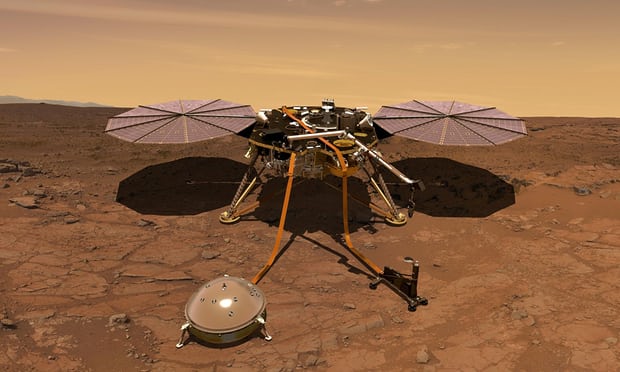InSight: Nasa lander asks Mars the questions Earth can't answer
- The New Space Race: NASA to Award 1st Contracts for Gateway Moon Base
- Astronomers Discover Dark-Matter Deficient Galaxy for 1st Time - NASA
Since the Earth and Mars were probably formed by similar processes 4.5bn years ago, the US space agency hopes the lander – officially known as Interior Exploration using Seismic Investigations, Geodesy and Heat Transport (InSight) – will shed light on what made them so different.
“How we get from a ball of featureless rock into a planet that may or may not support life is a key question in planetary science,” said Bruce Banerdt, InSight principal investigator at Nasa’s Jet Propulsion Laboratory in Pasadena, California. “We’d like to be able to understand what happened.”
On Earth these processes had been obscured over billions of years by earthquakes and the movement of molten rock in the mantle, he said.
 |
| Artist’s rendition of Mars InSight probe operating on the surface of Mars. Photograph: Nasa/Reuters |
But Mars – the fourth planet from the Sun, and Earth’s smaller and less geologically active neighbour – may yield more clues.
InSight aims to rest in an isolated spot and detect “Mars-quakes,” which Nasa described as “like a flashbulb that illuminates the structure of the planet’s interior”.
The lander will gather information using three instruments, including a seismometer, called the Seismic Experiment for Interior Structure, made by the French space agency. Banerdt called the seismometer “the heart of the mission”.
Scientists expect to pick up as many as 100 quakes during the mission, which should last at least 26 Earth months, or one Martian year.
Most of the quakes are expected to be less than magnitude 6.0.
Studying how seismic waves pass through the crust, mantle and core of Mars can help scientists learn more about what the layers are made of and how deep they are.
The second key instrument is a self-hammering probe that will monitor the flow of heat in the planet’s subsurface.
Called the Heat Flow and Physical Properties Package, it was made by the German space agency with the participation of the Polish space agency, and is the first of its kind to be used on Mars.
The probe should go 15 times deeper than any previous Mars mission, to a depth of three to five metres, said Nasa.
A third instrument will help scientists on Earth keep precise track of the lander’s location as Mars rotates.
The US spent $813.8m on the spacecraft and rocket launch, while investments on the instruments from France and Germany amount to $180 million, according to Nasa.

